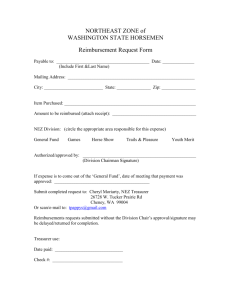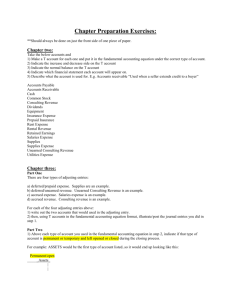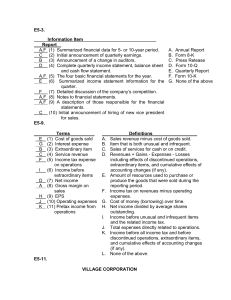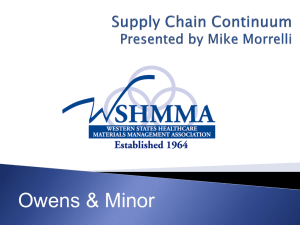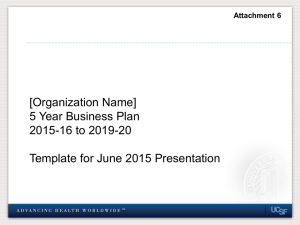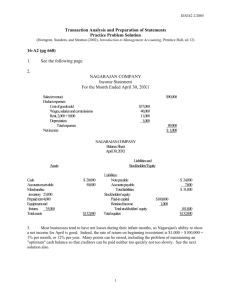Opening vignette
advertisement
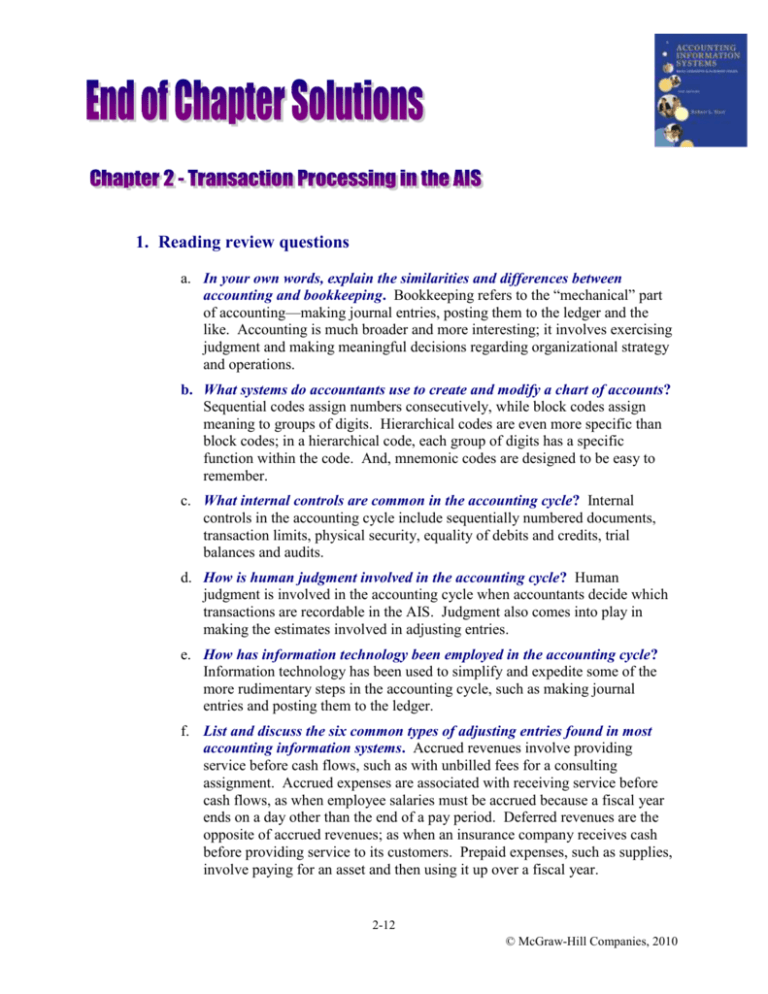
1. Reading review questions a. In your own words, explain the similarities and differences between accounting and bookkeeping. Bookkeeping refers to the “mechanical” part of accounting—making journal entries, posting them to the ledger and the like. Accounting is much broader and more interesting; it involves exercising judgment and making meaningful decisions regarding organizational strategy and operations. b. What systems do accountants use to create and modify a chart of accounts? Sequential codes assign numbers consecutively, while block codes assign meaning to groups of digits. Hierarchical codes are even more specific than block codes; in a hierarchical code, each group of digits has a specific function within the code. And, mnemonic codes are designed to be easy to remember. c. What internal controls are common in the accounting cycle? Internal controls in the accounting cycle include sequentially numbered documents, transaction limits, physical security, equality of debits and credits, trial balances and audits. d. How is human judgment involved in the accounting cycle? Human judgment is involved in the accounting cycle when accountants decide which transactions are recordable in the AIS. Judgment also comes into play in making the estimates involved in adjusting entries. e. How has information technology been employed in the accounting cycle? Information technology has been used to simplify and expedite some of the more rudimentary steps in the accounting cycle, such as making journal entries and posting them to the ledger. f. List and discuss the six common types of adjusting entries found in most accounting information systems. Accrued revenues involve providing service before cash flows, such as with unbilled fees for a consulting assignment. Accrued expenses are associated with receiving service before cash flows, as when employee salaries must be accrued because a fiscal year ends on a day other than the end of a pay period. Deferred revenues are the opposite of accrued revenues; as when an insurance company receives cash before providing service to its customers. Prepaid expenses, such as supplies, involve paying for an asset and then using it up over a fiscal year. 2-12 © McGraw-Hill Companies, 2010 Depreciation is akin to a prepaid expense, but involves plant assets. Finally, bad debts are estimates of uncollectible accounts receivable. g. Explain the purpose and structure of each general purpose financial statement. A balance sheet contains assets, liabilities and equity; it shows the financial position of an entity at a point in time. An income statement includes revenues and expenses, showing the results of operations on the accrual basis for a period of time. The statement of changes in equity links the balance sheet and the income statement. The statement of cash flows, divided into operating, investing and financing activities, explains the change in cash for a period of time. h. Respond to the questions for the chapter’s opening vignette. i. What does it mean to say that a chart of accounts is “block coded?” In a block coding system, items are grouped and then numbered according to those groupings. For example, assets start with “1.” ii. What other coding systems can organizations use for their chart of accounts? Organizations can also use sequential, mnemonic or hierarchical coding. Each system has its own advantages and disadvantages; the main point is using a system that is easily understood. iii. What are the advantages and disadvantages of using an Excel add-on for transaction processing? Advantages include: familiarity with Excel, potentially lower cost, and ease of use. Disadvantages include: having to create formulas and reports from scratch, lack of doubleentry accounting. 2. Reading review problem In discussing transaction processing at VISA, Marlin (“VISA Tests Transaction Processing System,” Information Week, no. 999 (July 26, 2004), p. 34) wrote: In today’s information-based, on-demand economy, credit card companies are being called upon to handle ever greater transaction volumes. In July 2004, VISA USA conducted a system stress test as part of its capacity planning process. The company’s transaction processing system managed 6,200 transaction messages per second, representing about 3,100 card purchases. Debit card transactions used more processing capacity than credit card transactions; debit transactions require tracking the movement of funds in real time, whereas credit transactions require a simple yes-or-no decision. A “debit card transaction” refers to purchasing goods or services with an ATM card. Many such cards can also be used for “credit card” transactions. a. Does the activity described above more closely resemble accounting or bookkeeping? Explain your answer. The activity described in Marlin’s article more 2-12 © McGraw-Hill Companies, 2010 closely resembles bookkeeping than accounting. It is focused on the mechanics of transaction processing, rather than on using the information for decisions. b. Use EDGAR to find the Form 10-K that VISA Inc. filed with the SEC on 21 November 2008. What AIS outputs are included in that filing? The 10-K itself could be considered an output of the AIS. It includes the following items in the section titled “Consolidated Financial Statements:” Report of Independent Registered Public Accounting Firm, Consolidated Balance Sheets, Consolidated Statements of Operations, Consolidated Statements of Changes in Shareholders’ Equity, Consolidated Statements of Comprehensive Income, Consolidated Statements of Cash Flows and Notes to the Consolidated Financial Statements. c. Develop a coding system for the operating revenue and operating expense accounts listed in VISA Inc.’s income statement (Consolidated Statements of Operations). Many answers are possible and acceptable here. I’m going to use a hierarchical coding system in which the first field denotes that the account is “operating” (as opposed to non-operating), the second field denotes whether the account is a revenue or an expense item, the third field denotes whether the item is domestic or international and the fourth field denotes the specific account. Using that system, here are the account numbers: Line item First Second Third Fourth Account field field field field number Service fees O 6 1 21 O6121 Data processing fees O 6 1 23 O6123 International transaction fees O 6 2 25 O6225 Other revenues O 6 1 27 O6127 Volume and support incentives O 6 1 29 O6129 Personnel O 7 1 31 O7131 Network, EDP and communications O 7 1 33 O7133 Advertising, marketing and promotion O 7 1 35 O7135 VISA International fees O 7 2 37 O7237 Professional and consulting fees O 7 1 39 O7139 Depreciation and amortization O 7 1 41 O7141 Administrative and other O 7 1 43 O7143 Litigation provision O 7 1 45 07145 d. Explain why the line items in VISA’s Statement of Cash Flows (such as Net Income and Cash Acquired through Reorganization) would not require account numbers. The line items in the Statement of Cash Flows do not represent accounts in the AIS; therefore, they do not need numbers. The amounts on the Statement of Cash Flows are derived from the other general purpose financial statements. For example, “net income” would come from the Consolidated Statement of Operations; “change in accounts receivable” would come from comparing the last two years’ Consolidated Statement of Financial Position. 2-12 © McGraw-Hill Companies, 2010 3. Making choices and exercising judgment a. Which of the following would be recordable transactions in an accounting information system? For each item that would not be a recordable transaction, explain why not. i. Purchasing land with a down payment and a note payable. Recordable. ii. Verifying an increase in the market value of land. Not recordable— the market value of land is not objective. iii. Establishing an exclusive relationship with a raw material supplier. Not recordable—nothing of value has exchanged hands. iv. Estimating the amount of warranty expense for the next accounting period. Recordable. v. Negotiating with an employees union for wage increases. Not recordable—the outcome of the negotiation is not certain, nor have the employees provided any service. b. How will principles-based accounting influence the design of accounting information systems? The steps in the accounting cycle? Principles-based accounting may not influence the fundamental design of the AIS—it will likely still have the same five basic parts. As for the accounting cycle, PBA may influence the ways transactions are recorded, since PBA focuses more on the substance of transactions than their form. c. Use EDGAR to obtain the 2008 financial statements for Home Depot Inc. and Lowes Companies Inc., two large firms in the home improvement industry. Compare their financial statements and comment on which company is stronger. Selected data from the companies’ financial reports is shown in the table below. Home Depot Lowe’s Net income $4,395 $2,809 Earnings per share $2.38 $1.90 Total assets $44,324 $30,869 Total equity $17,714 $16,098 Operating cash flow $5,727 $4,347 And, here are some interpretive ratios based on that data: Home Depot Net income / assets Net income / equity Equity / assets Operating cash flow / net income Lowe's 0.0992 0.0910 0.2481 0.1745 0.3996 0.5215 1.3031 1.5475 2-12 © McGraw-Hill Companies, 2010 The results are truly mixed. While Home Depot’s return on assets and equity are higher than Lowe’s, Home Depot is significantly more leveraged (and therefore more risky to an investor). That leverage may help explain, in part, the relationship between operating cash flow and net income for the two competitors. Being fairly risk-averse myself, I’d say Lowe’s is probably the stronger company—although that is a matter of judgment. 4. Field exercises Because the field exercises involve original research and will vary significantly from student to student, I’m not including any suggested solutions to them. If your students produce particularly outstanding responses and you’d like to send them to me, I’ll post them on the book’s web site. Let me know if this lack of suggested responses to field exercises is a major inconvenience for you. 5. Journal entries Record each of the following transactions in general journal format. a. b. c. d. e. f. g. Issued 50,000 shares of $1 par capital stock for $35 each. Billed customers for services provided, $10,000. Purchased supplies on account, $3,000. Paid monthly utility bill, $1,500. Verified 20% increase in market price of stock. Paid wages for the current month, $6,000. Purchased equipment with a list price of $50,000 by making a 20% down payment and financing the remainder with a 6-month, 12% note payable. h. Collected cash from customers, $5,000. i. Paid vendors, $1,400. j. Recorded one month’s accrued interest on note payable. A B C D E F Cash $1,750,000 Capital stock Additional paid-in capital Accounts receivable $10,000 Sales Supplies $3,000 Accounts payable Utility expense $1,500 Cash Not recordable Salary expense $6,000 $50,000 1,700,000 $10,000 $3,000 $1,500 2-12 © McGraw-Hill Companies, 2010 G H I J Cash Equipment Cash Note payable Cash Accounts receivable Accounts payable Cash Interest expense Interest payable $6,000 $50,000 $10,000 40,000 $5,000 $5,000 $1,400 $1,400 $400 $400 6. Adjusting entries The unadjusted trial balance for GLP Corporation appears below: GLP Corporation Trial balance September 30, 20x4 Debit Cash $ 6,000 Accounts receivable 2,500 Allowance for bad debts Inventory 4,500 Supplies 800 Equipment 15,000 Accumulated depreciation--equipment Accounts payable Notes payable Deferred fees Capital stock Additional paid-in capital Retained earnings Sales Cost of goods sold 13,500 Advertising expense 5,000 Wages expense 12,000 Miscellaneous expense 1,000 Totals $ 60,300 Credit $ 200 10,000 1,200 6,000 900 7,000 8,000 11,000 16,000 $ 60,300 End-of-period analysis revealed the following: a. The market value of equipment had decreased by 30% of its original cost. Depreciation for the quarter totaled $1,000. Depreciation expense Accumulated depreciation $1,000 $1,000 2-12 © McGraw-Hill Companies, 2010 b. The note payable was signed on August 1, 20x4. Its interest rate was 10%, and no interest had been recorded since the signing. Interest expense Interest payable c. $100 $100 Unpaid employee wages at September 30 totaled $1,000. Wages expense Wages payable d. $1,000 $1,000 Deferred fees represented a consulting contract signed at the beginning of September. The contract’s duration is 3 months, and the work is spread evenly throughout the contract period. Deferred fees Fees earned e. $300 $300 Supplies on hand totaled $150. Supplies expense Supplies f. $650 $650 The market value of capital stock had increased by 15%. No entry required g. Actual bad debt write-offs during September were $300; 1% of sales will likely become uncollectible in the coming period. Bad debt expense Allowance for bad debts $160 $160 Prepare the required adjusting entries based on the preceding information. Then, prepare an adjusted trial balance. The adjusted trial balance appears on the next page. 2-12 © McGraw-Hill Companies, 2010 GLP Corporation Adjusted trial balance September 30, 20x4 Cash Accounts receivable Allowance for bad debts Inventory Supplies Equipment Accumulated depreciation Accounts payable Notes payable Deferred fees Interest payable Wages payable Capital stock Additional paid-in capital Retained earnings Sales Fees earned Cost of goods sold Advertising expense Wages expense Miscellaneous expense Depreciation expense Interest expense Supplies expense Bad debt expense $ 6,000 2,500 $ 360 4,500 150 15,000 11,000 1,200 6,000 600 100 1,000 7,000 8,000 11,000 16,000 300 $ 13,500 5,000 13,000 1,000 1,000 100 650 160 62,560 $ 62,560 7. Financial statements Use the adjusted trial balance from Problem 5 to prepare an income statement for the quarter ended 9 / 30 / 20x4 and a balance sheet as of 9 / 30 / 20x4 for GLP Corporation. 2-12 © McGraw-Hill Companies, 2010 GLP Corporation Income statement For the quarter ended 9 / 30 / 20x4 Sales $ Fees earned Cost of goods sold Gross profit Operating expenses: Advertising expense $ Wages expense Depreciation expense Supplies expense Bad debt expense Miscellaneous expense Operating loss Interest expense Net loss 16,000 300 $ $ 5,000 13,000 1,000 650 160 1,000 16,300 (13,500) 2,800 $ (20,810) (18,010) 100 (18,110) $ 12,790 $ 4,000 16,790 $ 8,900 $ 7,890 16,790 $ GLP Corporation Balance sheet As of 9 / 30 / 20x4 Assets Current assets Cash $ Accounts receivable (net) Inventory Supplies Plant assets Equipment (net) Total assets Liabilities & Equity Current liabilities Accounts payable Notes payable Deferred fees Interest payable Wages payable $ Equity Capital stock $ Additional paid-in capital Retained earnings Total liabilities & equity 6,000 2,140 4,500 150 1,200 6,000 600 100 1,000 7,000 8,000 (7,110) 2-12 © McGraw-Hill Companies, 2010 8. Coding systems Which type of coding system is indicated in each of the following independent situations? Be prepared to explain your reasoning. a. Airport codes (LAX, OGG) mnemonic b. Automatically assigned transaction numbers in a cash register sequential c. Consecutively numbered purchase orders (101, 102, 103 and so on) sequential d. Dewey Decimal System (used to classify library books) hierarchical e. Invoice numbers sequential f. National Association of Home Builders chart of accounts (look this one up on the Internet) block g. Standard chart of accounts included with Quickbooks block h. Telephone numbers block i. Universal Product Codes (UPCs) block j. ZIP codes (91768, 63135) hierarchical 9. Crossword puzzle 1 C 2 3 B O O K K E E P M X M T U E N R I N G 4 M 5 I I C N T E R N A A L T 6 A L C R E D I T 7 T C A S H 8 I D I 9 N G M E A S U R B I N G G I 10 I D E N T I F Y I N G Created with EclipseCrossword — www.eclipsecrossword.com 2-12 © McGraw-Hill Companies, 2010 10. Terminology Please match each item on the right with the most appropriate item on the left. 1. F 6. G 2. D 7. A 3. C 8. H 4. B 9. E 5. I 10. J 11. Multiple choice questions 1. C 6. A 2. D 7. C 3. C 8. C 4. A 9. B 5. D 10. A 12. Statement evaluation 1. C 2. B If the transaction, for example, is an accrued expense adjustment, this statement will be true. 3. A 4. B Block coding is one option, but is not a requirement. 5. C 6. B The statement describes accrued revenue; accrued expenses are also an option. 7. C 8. A 9. A 10. A 2-12 © McGraw-Hill Companies, 2010 13. International Financial Reporting Standards Do an Internet search for information on IFRS. Visit at least two web sites, including the International Accounting Standards Board, and respond to the following questions about IFRS: a. Compare and contrast the IFRS framework with the FASB Conceptual Framework discussed in Chapter 1. List three similarities and three differences between the two. Similarities include (but are not limited to): Both frameworks were developed by a standards board (FASB and IASB). The structure of the two frameworks is similar. They both include some common elements, such as objectives of financial statements/ financial reporting and elements of financial statements. On the other hand, the frameworks differ in the following ways: The qualitative characteristics are different between the two frameworks. The IFRS framework identifies five elements of financial statements; the FASB framework, eight. The IFRS framework includes a section titled “Concepts of Capital and Capital Maintenance,” but the FASB framework does not. b. Choose two countries that have adopted IFRS. If an organization had operations in both countries, how would you communicate that fact in their chart of accounts? A list of countries that have adopted IFRS is available at http://www.iasplus.com/country/useias.htm. To communicate multi-national operations via a chart of accounts, you could use a hierarchical code that includes a mnemonic abbreviation for the country. For example, if Cash is account #101, DEN101 could denote Cash in the Denmark branch and AUS101 could denote Cash in the Australian branch. Other systems are definitely possible as well. 2-12 © McGraw-Hill Companies, 2010

